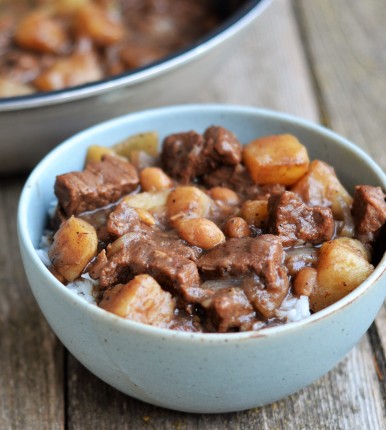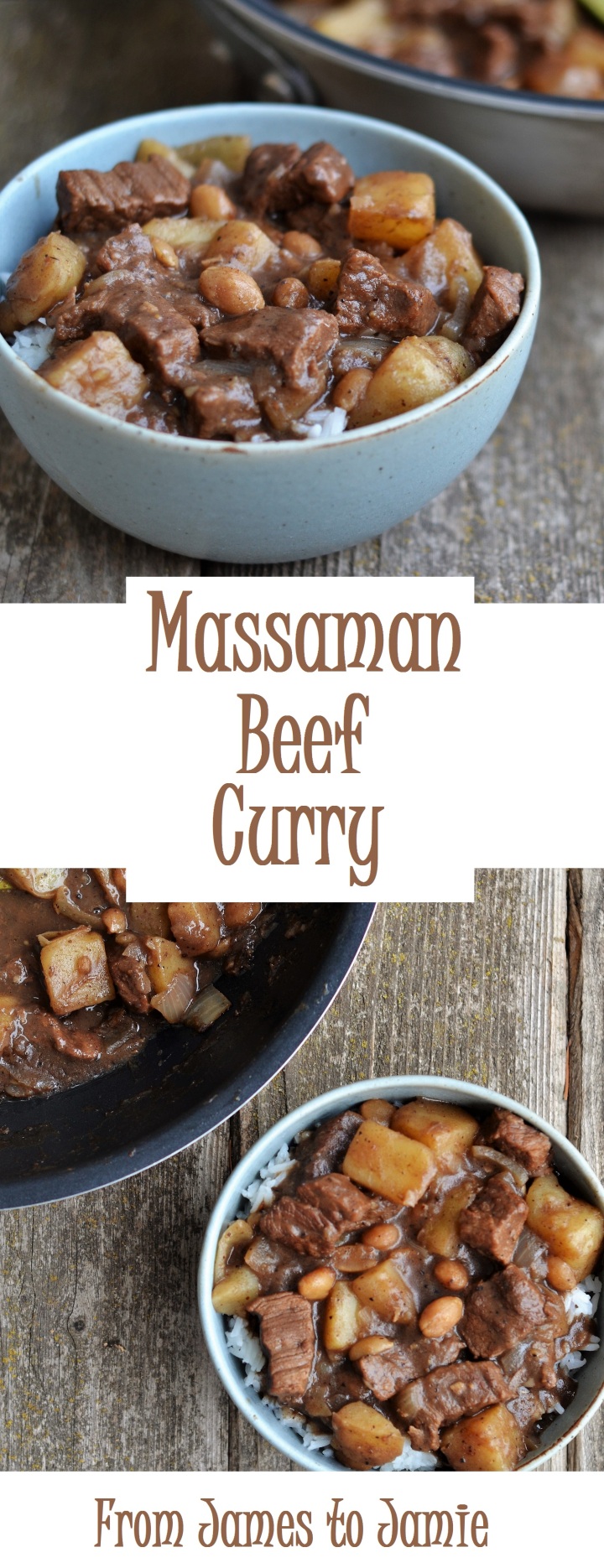Since moving to our new apartment in our new city, my wife and I have made a concerted effort to get to know our new home and the surrounding area. We’ve tried a wide variety of restaurants in the area as well, and have picked up a few favourites along the way. Our city has a very large Indo-Canadian population, and that obviously means that there are some really good options for curry to be found.
In fact, it’s so easy to get a good curry around here that I’ve sort of neglected to make my own for a while now. It’s a shame really, as so many grocers in the area either specialize in Indian spices and goods, or at least make an attempt to devote extra shelf-space for such items.
Now I know that this isn’t an Indian dish (it’s Thai, for those unfamiliar with this particular curry), but it gave me the excuse I needed to stock up in numerous spices that were amazingly dirt cheap and obviously used in more cuisines than just Indian. Actually, it also gave me the excuse to buy a beautiful Le Creuset mortar and pestle. It wasn’t nearly as cheap as the spices (obviously), so I guess it’s a good thing I saved so much in the spice department.
On an entirely different note, I think I need to point out something for which I am very proud: I’ve written three whole paragraphs (albeit short ones) to introduce this recipe, and I haven’t yet mentioned the word “poo”. Rather, I haven’t mentioned the name “Poo”, the person from whom I adapted this recipe. Jamie Oliver featured her on his “Food Tube” page, where she showed him how to make Massaman curry. I watched the video dozens of times to ensure I caught every last detail (there was no typed-up recipe to accompany the video), adjusted a few things out of necessity or desire to be slightly different (or because measurements weren’t specified), and voila: a very delicious Massaman Beef Curry that’s inspired by Poo, but thankfully tastes nothing like how terrible that sounds.
Massaman Beef Curry
Ingredients:
For the paste:
- 1 tbsp. fennel seed

- 1 tbsp. corriander seeds
- 1 tbsp. cardamom pods
- 1 tbsp. black peppercorns
- 2 tsp. crushed red pepper
- 2 tsp. whole cloves
- 1 tbsp. cinnamon
- 1/4 onion, chopped
- 5 cloves garlic, sliced (or 2 cloves Russian garlic)
- 1 thumb-size piece ginger, peeled and sliced
- 1 tbsp. lemongrass paste
For the curry:
- 500 g. flank steak, cubed
- 1 can (400 ml.) coconut milk
- 400 ml. water
- 1-2 handfuls roasted peanuts
- 2 tbsp. tamarind paste
- 3 bay leaves
- 2 tbsp. packed brown sugar
- 2 tbsp. fish sauce
- 3 medium-sized yellow flesh potatoes, diced
- 3/4 onion, chopped
Directions:
For the paste:
- In a large wok or deep frying pan, toss in the fennel, corriander, cardamom, peppercorns, crush red pepper and cloves. Toast over medium heat for a few minutes.
- Remove from heat and pick out the cardomom pods. Crack the pods open and collect the seeds. Using a pestle and mortar, grind the seeds until fine. Add the rest of the spices from the wok and grind until fine. Remove the ground spices to a bowl.
- Turn the wok heat up to medium-high and add in the onion, garlic, and ginger. Dry roast these ingredients for 4 minutes, stirring occasionally so they don’t burn and stick.
- Place the roasted fresh ingredients into the mortar. Add about a third of the ground spices (this dries out the fresh ingredients a bit so they don’t slide around as much) and begin grinding. Once the majority of the bigger pieces of fresh ingredients are broken down, add the remainder of the grounded spices, along with the ground cinnamon and lemongrass paste. Grind until you have a fine paste.
- The paste can be made ahead of time and refrigerated for a few days, or frozen for longer.
For the curry:
- In the same wok, now over medium-high heat, add a small amount of the coconut milk and let it reduce for about 2 minutes. Add a third of the curry paste from above (about 2 heaping tablespoons), mixing well with the reduced coconut milk, and cook for another 2 minutes.
- Toss in the beef and stir together well. Cook for a couple minutes, until the majority of the beef’s exterior is browned.
- Pour in the remaining coconut milk, then fill the empty can with water (400 ml.) and add that as well.
- Toss in the peanuts, tamarind paste, bay leaves, brown sugar, fish sauce, potatoes and onion.
- Bring everything to a boil, then turn the element down to low-medium and simmer for 1 hour, stirring occasionally. The sauce should reduce nicely in this time, but you may need a few extra minutes to get it to your desired thickness. If it gets too thick before it’s had a chance to simmer the full hour, add a little water.
- Serve over white rice and enjoy!
Serves 4

Just as I usually do, I’m sharing this over at Fiesta Friday. It’s the only link party that I continually join, and I keep going back because of the bloggers I’ve met there that gave me such encouragement as I first started out. If you get a chance, head over there to see what they’re cooking up in their own homes. This week are Julianna @ Foodie On Board and Hilda @ Along The Grapevine.

Looks like a great dish for the winter!
LikeLiked by 1 person
Thanks, Matt. By the way, totally made perogies the other day after seeing your post.
LikeLike
Perfect! I love this style of curry! We order it every time we go out for Thai. I have been making my own at home, using a commercial mussamam paste. I am going to try your recipe for sure, as it sounds and looks so good.
Thanks so much for bringing this to FF this week! 😀
LikeLiked by 2 people
Thanks, Julianna! I’ve never actually ordered it in a Thai restaurant before, so I’m excited to find it on a menu and order it. I used to always buy my curry pastes, but there’s something therapeutic about making it yourself. I’m sure you could do a pretty job in a food processor too, if you don’t have a pestle and mortar or don’t have the time to grind it fine.
LikeLike
Wow, this recipe is just loaded with flavor. I have been wanting to try more curry dishes and we are fortunate to have Indian grocers here too that sell spices that I already use in so many things really cheap! I’ll be trying this one.
LikeLiked by 2 people
Awesome – let me know when you do, Julie.
LikeLiked by 1 person
I love a good massaman curry and this looks delicious! 🙂
LikeLiked by 1 person
Thanks, Petra!
LikeLiked by 1 person
The recipe looks and sounds so delicious 😀
LikeLike
xx
LikeLike
The recipe says to add a third of the curry paste – at what point do you add the remaining paste?
LikeLike
Sorry, I am just seeing here that I didn’t clarify that – and that I’ll need to make that correction. You only need 1/3 of the curry paste for the recipe, and the rest can be frozen for future use. It’s quite the process to make the paste, involving many ingredients in smallish quantities, so to me it makes more sense to make a larger batch and have some that you can save.
LikeLike